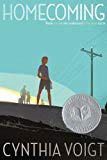
Homecoming is a young adult novel which tells the story of the four Tillerman children - Dicey, Sammy, James, and Maybeth - after they are abandoned by their mother in a Connecticut mall parking lot. Not knowing where to turn, the four children decide to walk to Bridgeport, almost a hundred miles away, where they believe their closest relative is living. They endure both hunger and danger along the way, but the children's long journey eventually ends when they end up with their grandmother in Maryland.
Other characters include: Windy and Stewart, two college students who shelter, feed and help the Tillerman family for one night in New Haven before Stewart drives the children to Bridgeport but neither young man seems to care about what happens to them; Will Hawkins, the owner of a circus; and Claire, a dog trainer in the circus, who rescue and help the Tillermans, who both return to see if the Tillerman children are all right at their grandmother's house. And the two boys Tom and Jerry who help them with crossing the ocean. Sub-characters also include two teenagers that they meet at the state park they stayed in for a few days, Edie and Louis.
Already have an account? Log In Now